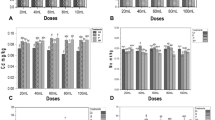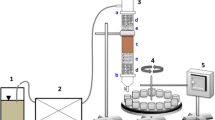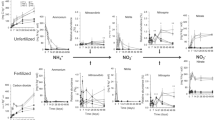Abstract
Microbially catalyzed reactions, which occur in the natural sulfur cycle, have been integrated in a microbiological process to remove toxic metals from contaminated soils. Bioleaching using sulfuric acid produced by sulfur-oxidizing bacteria was followed by precipitation of the leachate metals as insoluble sulfides by sulfate-reducing bacteria. Metal contaminants including Cd, Co, Cr, Cu, Mn, Ni, and Zn were efficiently leached from an artificially contaminated soil. Mn, Ni, and Zn were the only target elements that were significantly leached from soil minerals. Pb leaching was slow and remained incomplete over a period of 180 days. Mineral components such as Fe, Ca and Mg were also leached but the eventual reduction in soil mass was only approximately 10%. An industrially contaminated soil was also efficiently leached and approximately 69% of the main toxic metals present, Cu, Ni, and Mn, were removed after 175 days. The leachate that resulted from the action of sulfur-oxidizing bacteria on contaminated soil was stripped of metals using an anaerobic bioreactor containing a mixed culture of sulfate-reducing bacteria which precipitated soluble metal species as solid metal sulfides. More than 98% of the metals were removed from solution with the exception of Mn, Ni, and Pb, where 80–90% were removed. The metal content of the resultant effluent liquor was low enough to meet European criteria for discharge into the environment.
This is a preview of subscription content, access via your institution
Access options
Subscribe to this journal
Receive 12 print issues and online access
$209.00 per year
only $17.42 per issue
Buy this article
- Purchase on Springer Link
- Instant access to full article PDF
Prices may be subject to local taxes which are calculated during checkout
Similar content being viewed by others
References
Ehrlich, H.L. 1996. How microbes influence mineral growth and dissolution. Chem. Geol. 132: 5–9.
Gadd, G.M. 1996. Roles of microorganisms in the environmental fate of radionuclides. Endeavour 20: 150–156.
Norris, P.R. 1990. Acidophilic bacteria and their activity in mineral sulfide oxidation, pp. 3–28 in Microbial mineral recovery. Ehrlich, H.L. and Brierley, C.L (eds.). McGraw-Hill Publishing Company, New York.
Tuovinen, O.H. 1990. Biological fundamentals of mineral leaching processes, pp. 55–78 in Microbial mineral recovery. Ehrlich, H.L. and Brierley, C.L. (eds.). McGraw-Hill Publishing Company, New York.
Rawlings, D.E. and Silver, S. 1995. Mining with microbes. Bio/Technology 13: 773–778.
Bosecker, K. 1997. Bioleaching: metal solubilization by microorganisms. FEMS Microbiol. Rev. 3–4: 591–604.
Widdel, F. 1988. Microbiology and ecology of sulfate- and sulfur-reducing bacteria, pp. 469–585 in Biology of anaerobic microorganisms. Zehner, A.B. (ed.). John Wiley and Sons, New York.
Widdel, F. and Hansen, T.A. (eds.). 1991. The prokaryotes. The dissimilatory sulphate and sulphur reducing bacteria, 2nd ed. Springer Verlag, New York.
Hansen, T.A. 1993. Carbon metabolism in sulfate-reducing bacteria, pp. 21–40 in The sulfate-reducing bacteria: contemporary perspectives. Odom, J.M. and Singleton, R. (eds.). Springer Verlag, New York.
Peck, H.D. 1993. Bioenergetic strategies of the sulfate-reducing bacteria, pp. 41–75 in The sulfate-reducing bacteria: contemporary perspectives. Odom, J.M. and Singleton, R. (eds.). Springer-Verlag, New York.
Luoma, S.N. 1990. Processes affecting metal concentrations in estuarine and coastal marine sediments, pp. 51–66 in Heavy metals in the marine environment. Furness, R.W. and Rainbow, RS. (eds.). CRC Press, Boca Raton, FL.
Barnes, L.J., Scheeren, P.J.M., and Buisman, C.J.N. 1994. Microbial removal of heavy metals and sulphate from contaminated groundwaters, pp. 38–49 in Emerging technology for bioremediation of metals. Means, J.L. and Hinchee, R.E. (eds.). Lewis Publishers, Boca Raton, FL.
Gadd, G.M. 1993. Microbial formation and transformation of organometallic and organometalloid compounds. FEMS Microbiol. Rev. 11: 297–316.
Gadd, G.M. and White, C. 1993. Microbial treatment of metal pollution—a working biotechnology? Trends Biotechnol. 11: 353–359.
Zagury, G.J., Narasiah, K.S., and Tyagi, R.D. 1994. Adaptation of indigenous iron-oxidizing bacteria for bioleaching of heavy-metals in contaminated soils. Environ. Technol. 15: 517–530.
Sreekrishnan, T.R. and Tyagi, R.D. 1995. Sensitivity of metal-bioleaching operation to process variables. Process Biochem. 30: 69–80.
White, C. and Gadd, G.M. 1996. Mixed sulphate-reducing bacterial cultures for bioprecipitation of toxic metals: factorial and response-surface analysis of the effects of dilution rate, sulphate and substrate concentration. Microbiol. 142: 2197–2205.
White, C. and Gadd, G.M. 1996. A comparison of carbon/energy and complex nitrogen sources for bacterial sulphate-reduction: potential applications to bioprecipitation of toxic metals as sulphides. J. Indust. Microbiol. 17: 116–123.
White, C. and Gadd, G.M. 1997. An internal sedimentation bioreactor for laboratory-scale removal of toxic metals from soil leachates using biogenic sulphide precipitation. J. Indust. Microbiol. Biotechnol. 18: 414–421.
Chang, J.C. 1993. Solubility product constants, pp. 8–39 in CRC handbook of chemistry and physics. Lide, D.R. (ed.). CRC Press, Boca Raton, FL.
Hammack, R.W. and Edenborn, H.M. 1992. The removal of nickel from mine waters using bacterial sulphate-reduction. Appl. Microbiol. Biotechnol. 37: 674–678.
Gardiner, J. and Zabel, T. 1991. United Kingdom water quality standards arising from European Community directives—an update. The Water Research Council, London.
White, C. and Gadd, G.M. 1995. Determination of metals and metal fluxes in algae and fungi. Sci. Tot. Environ. 176: 107–115.
Author information
Authors and Affiliations
Rights and permissions
About this article
Cite this article
White, C., Shaman, A. & Gadd, G. An integrated microbial process for the bioremediation of soil contaminated with toxic metals. Nat Biotechnol 16, 572–575 (1998). https://doi.org/10.1038/nbt0698-572
Received:
Accepted:
Issue Date:
DOI: https://doi.org/10.1038/nbt0698-572
This article is cited by
-
Metal contamination and bioremediation of agricultural soils for food safety and sustainability
Nature Reviews Earth & Environment (2020)



